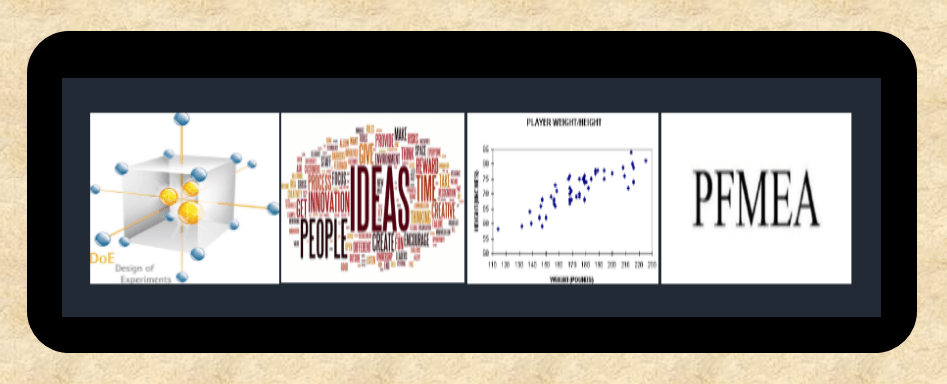APQP is a structured approach to product and process design. This framework is a standardized set of quality requirements that enable suppliers to design a product that satisfies the customer.
The primary goal of product quality planning is to facilitate communication and collaboration between engineering activities. A Cross-Functional Team (CFT), involving marketing, product design, procurement, manufacturing and distribution, is used in the APQP process. APQP ensures the Voice of the Customer (VOC) is clearly understood, translated into requirements, technical specifications and special characteristics. The product or process benefits are designed in through prevention.
Failure Mode and Effects Analysis (FMEA)
Failure Mode and Effects Analysis (FMEA) is a structured approach to discovering potential failures that may exist within the design of a product or process.
Failure modes are the ways in which a process can fail. Effects are the ways that these failures can lead to waste, defects or harmful outcomes for the customer. Failure Mode and Effects Analysis is designed to identify, prioritize and limit these failure modes.
FMEA is not a substitute for good engineering. Rather, it enhances good engineering by applying the knowledge and experience of a Cross-Functional Team (CFT) to review the design progress of a product or process by assessing its risk of failure.
There are two broad categories of FMEA, Design FMEA (DFMEA) and Process FMEA (PFMEA)
Measurement System Analysis (MSA Studies)
MSA is defined as an experimental and mathematical method of determining the amount of variation that exists within a measurement process. Variation in the measurement process can directly contribute to our overall process variability. MSA is used to certify the measurement system for use by evaluating the system’s accuracy, precision and stability.
Statistical Process Control (SPC)
SPC is a method of measuring and controlling quality by monitoring the manufacturing process. Quality data is collected in the form of product or process measurements or readings from various machines or instrumentation. The data is collected and used to evaluate, monitor and control a process. SPC is an effective method to drive continuous improvement. By monitoring and controlling a process, we can assure that it operates at its fullest potential. One of the most comprehensive and valuable resources of information regarding SPC is the manual published by the Automotive Industry Action Group (AIAG)
Production Part Approval Process (PPAP)
PPAP defines the approval process for new or revised parts, or parts produced from new or significantly revised production methods. The PPAP process consists of 18 elements that may be required for approval of production level parts. Not all of the elements are required for every submission. There are five generally accepted PPAP submission levels. The PPAP manual contains detailed information, guidelines and sample documents useful for completing the process requirements. The resulting PPAP submission provides the evidence that the supplier has met or exceeded the customer’s requirements and the process is capable of consistently reproducing quality parts.
Other Automotive industries techniques:
1) Quality function deployment QFD techniques
- Meaning of QFD principles
- Uses of QFD principles
- Aspect of QFD
- Benefit of QFD
- Graphical representation of QFD principles
- QFD methodology
2) Design of experiment DOE techniques
- Meaning of DOE
- Uses of DOE principles
- The benefit of DOE principles
- Graphical representation of DOE principles.
3) Scatter diagram techniques
- Meaning of Scatter diagram
- Uses of Scatter diagram
- Graphical representation of Scatter diagram.
4) Process Failure Mode Effect Analysis (PFMEA) techniques
- Meaning of PFMEA documentation
- Graphical representation and explanation of key features of Process FMEA documentation.
- HINTS: in calculating RPN in PFMEA documentation.
- Analyzing the PFMEA documentation.
- An example of Rating definitions in PFMEA documentation.
- Steps 1-9 in Graphical representation and Guidelines.
- Summary steps to complete a PFMEA documentation.
5) Histogram techniques
- Introduction of Histogram
- Importance of Histogram, Usefulness of Histogram
- Graphical representation of Histogram
6) Kano model principles/techniques
- Introduction to Kano model principles
- Graphical representation and explanation of Kano model principles.
7) 5S principles/techniques
- Meaning of 5S principles/techniques
- 5S acronym i.e. sort, set, shine, standardize
8) Brainstorming principles/techniques
- Introduction of Brainstorming techniques
- Advantages of Brainstorming techniques
- Brainstorming techniques process
- Types of Brainstorming techniques
- How to carry out a Brainstorming study
Clients benefits: The training module will secure the clients to have the following benefits:
- Greater productivity is enhanced
- Smoother operations are ascertained
- Greater flexibility and responsiveness
- Eliminates defects (in-house and at the customer side)
- Reduce customer complaints like 8D
- Improve product quality
- Improve 5S principles at the manufacturing
- Increased customer satisfaction
- Reduce returns of product
- Increase customer approval process and release of a production line within timeframe schedule
Who are the benefactors of these training modules or the target groups:
- Plant Managers
- Quality Managers
- Quality Engineers
- Production leaders
- Process engineers
- Quality Supervisors
- Quality Specialist
- Logistics
- Technology
- Production
- and others categories who are interested in leaning: Problem-solving techniques, Continuous improvement process PDCA, Brainstorming techniques, 5S methodology, FMEA methodology, Statistical Process Control SPC philosophy, Advanced Product Quality Planning APQP, Production Part Approval Process PPAP for production lines release, leaning or engage in Measurement System Analysis MSA studies and carry out process documentation in their production plant effectively etc
The training modules acquire from Hermon Quality Solutions HQS services will help you to get your career professionals smoothly and efficiently. Why not give it a try and see the difference.
Let’s get in touch!!!

